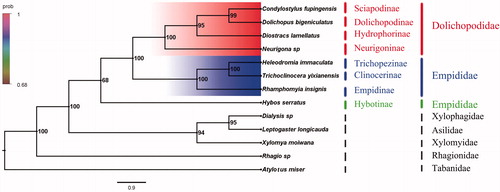Abstract
The dance fly Hybos serratus Yang et Yang belongs to the subfamily Hybotinae of Empididae. The mitogenome of H. serratus was sequenced, the first representative of the mitogenome of the subfamily. The nearly complete mitogenome is 15,997 bp totally, consisting of 13 protein-coding genes, two rRNAs and 22 transfer RNAs. All genes have the similar locations and strands with that of other published species of Empididae. The nucleotide composition biases towards A and T, which together made up 79% of the entirety. Bayesian inference analysis strongly supported the monophyly of Empidoidea and Dolichopodidae. This result also suggested that Hybotinae is assigned to the sister group to the clade of Dolichopodidae and Empididae.
Introduction
Empididae is one of the largest families in Diptera with over 5000 described species from the world (Yang et al. Citation2007). They capture aphids, psyllids and coccids of Hemiptera, but also other true flies such as mosquitos, blackflies and so on. They are widely used as a biological indicator of evaluating the quality of environment and biodiversity (Yang and Yang Citation2003).
The specimens of Hybos. serratus used for this study were collected in Zhouzhi County of Shaanxi Province by Xuankun Li, and identified by Ding Yang. Specimens are deposited in the Entomological Museum of China Agricultural University (CAU). The total genomic DNA was extracted from the whole body (except head) of the specimen using the QIAamp DNA Blood Mini Kit (Qiagen, Germany) and stored at –20 °C until needed. The mitogenome was amplified and sequenced as described in our previous study (Wang et al. Citation2016a, Citation2016b, Citation2016c). The nearly complete mitogenome of H. serratus is 15,997bp. It encoded 13 PCGs, 22 tRNA genes, and two rRNA genes and the control region could not be sequenced entirely in this study, and were similar with related reports before (Kang et al. Citation2016; Li et al. Citation2016; Wang et al. Citation2016a, Citation2016c; Li et al. Citation2017; Zhou et al. Citation2017; Gao et al. Citation2018; Qilemoge et al. Citation2018). All genes have the similar locations and strands with that of other published Empididae species. The nucleotide composition of the mitogenome was biased towards A and T, with 79% of A + T content (A = 40.3%, T = 38.7%, C = 12.5%, G = 8.5%). The A + T content of PCGs, tRNAs, and rRNAs is 76.8%, 78.8%, and 82.2%, respectively. The total length of all 13 PCGs of H. serratus is 11,192 bp. Five PCGs (ATP8, NAD2, NAD3, NAD5, and NAD6) initiated with ATT codons, and five PCGs (COII, COIII, ATP6, NAD4, and CYTB) initiated with ATG codons, NAD4L initiated with ATA as a start codon, CO1 and NAD1 initiated with TCG and TTG as a start codon, respectively. Eleven PCGs used the typical termination codons TAA, two PCGs (CO1 and NAD5) used T in H. serratus.
Phylogenetic analysis was performed based on the nucleotide sequences of 13 PCGs from 13 Diptera species. Bayesian inference (BI) analysis generated the phylogenetic tree topologies based on the PCGs matrices (). According to the phylogenetic result, the monophyly of Empidoidea was strongly supported. The monophyletic Dolichopodidae was assigned to the sister to the clade of Empididae that consists of Empidinae, Clinocerinae, and Trichopezinae in this study. For the phylogeny of Empididae, the Empidinae is the sister group to the clade of Clinocerinae + Trichopezinae, but the Hybotinae is the sister group to the clade of Dolichopodidae and Empididae. This result about the classification status of Hybotinae is consistent with the phylogenetic result of previous studies (Wahlberg and Johanson Citation2018). The mitogenome of H. serratus could provide the important information for the further studies of Empidoidea phylogeny.
Disclosure statement
No potential conflict of interest was reported by the authors.
Additional information
Funding
References
- Gao S, Tang C, Wang N, Yang D. 2018. The mitochondrial genome of Diostracus lamellatus (Diptera: Dolichopodidae). Mitochondrial DNA B. 3:346–347.
- Gao S, Zhou J, Cao Y, Zhang J, Yang D. 2018. The mitochondrial genome of Trichoclinocera yixianensis (Diptera: Empididae). Mitochondrial DNA B. 3:452–453.
- Kang Z, Li X, Yang D. 2016. The complete mitochondrial genome of Dixella sp. (Diptera: Nematocera, Dixidae). Mitochondrial DNA A. 27:1528–1529.
- Li X, Ding S, Hou P, Liu X, Zhang C, Yang D. 2017. Mitochondrial genome analysis of Ectophasia rotundiventris (Diptera: Tachinidae). Mitochondrial DNA B. 2:457–458.
- Li X, Wang Y, Su S, Yang D. 2016. The complete mitochondrial genomes of Musca domestica and Scathophaga stercoraria (Diptera: Muscoidea: Muscidae and Scathophagidae). Mitochondrial DNA A. 27:1435–1436.
- Qilemoge, Gao S, Tang C, Wang N, Yang D. 2018. The mitochondrial genome of Diostracus lamellatus (Diptera: Dolichopodidae). Mitochondrial DNA Part B. 3:346–347.
- Wahlberg E, Johanson K. 2018. Molecular phylogenetics reveals novel relationships within Empidoidea (Diptera). Syst Entomol. doi:10.1111/syen.12297.
- Wang K, Ding S, Yang D. 2016a. The complete mitochondrial genome of a stonefly species, Kamimuria chungnanshana Wu, 1948 (Plecoptera: Perlidae). Mitochondrial DNA A DNA Mapp Seq Anal. 27:3810–3811.
- Wang K, Li X, Ding S, Wang N, Mao M, Wang M, Yang D. 2016b. The complete mitochondrial genome of the Atylotus miser (Diptera: Tabanomorpha: Tabanidae), with mitochondrial genome phylogeny of lower Brachycera (Orthorrhapha). Gene. 586:184–196.
- Wang K, Wang Y, Yang D. 2016c. The complete mitochondrial genome of a stonefly species, Togoperla sp. (Plecoptera: Perlidae). Mitochondrial DNA A. 27:1703–1704.
- Yang D, Yang C. 2003. Fauna Sinica Insecta. Vol. 34. Diptera Empididae. Beijing: Science Press.
- Yang D, Zhang K, Yao G, Zhang J. 2007. World catalog of Empididae (Insecta: Diptera). Beijing: China Agricultural University Press.
- Zhou Q, Ding S, Li X, Zhang T, Yang D. 2017. Complete mitochondrial genome of Allognosta vagans (Diptera, Stratiomyidae). Mitochondrial DNA B. 2:461–462.

